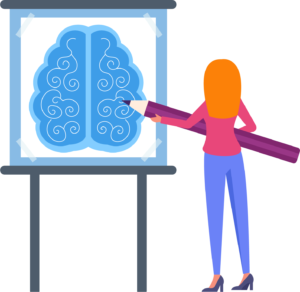
We’re taking the confusion out of marketing vocabulary. No need to falter when someone mentions churn rate or wireframe. Read on to better understand everyday marketing terms and be sure to bookmark this so you can come back anytime you run into a phrase you’re unsure of.
A
a/b testing
Comparing a single variable to another with the goal of optimizing the creative. (ex. An online ad with the same background, but two different copy options.)
advertising
Three main goals: inform customers of new products, persuade customers to buy new products, and remind customers why they need the products.
affiliate marketing
A marketing relationship based on value/commission sharing between online advertisers and website publishers that helps to extend advertising reach.

algorithm
This most often refers to social media or search engine algorithms that ensure the user is viewing content most closely related to their interests or to their queries.
alt text
This is text that’s found when an image is hovered over (but not a caption, that’s below the image) and is used to make webpages more accessible to screen readers; also allows search engines to better understand images.
analytics
Discovering meaningful connections and patterns in the data.
anchor text
This is the text that’s highlighted and hyperlinked within content that sends users to another page; should be relevant to the page that is being linked to.
application programming interface (API)
Software that allows two different apps to communicate.
B
B2B marketing
Refers to companies that sell to other companies. Ex. MailChimp.
B2C marketing
Companies that sell directly to consumers. Ex. Starbucks.
backlinks
These are purposeful, high-quality links from an outside site back to a company’s site and are part of what determines the popularity and ranking of sites.
bounce rate
When someone visits a site and leaves without clicking on anything.
brand identity
The elements that make up the appearance of a brand that users/customers see like the logo, the color scheme, the font packages, etc.
breadcrumbs
Website navigation that shows users where they’ve been so they can get back to where they started; appears at the top of the page and below the header.
browser extension
Add-ons to internet browsers that provide users with various services; some provide discounts, some provide grammar assistance.
C
call-to-action (CTA)
These are buttons or other obvious links that prompt customers and users to take an action that function as the primary points of conversion and their placement can determine the success of a website.
Outline of how a business has solved a customer’s problem; shows potential clients how a business can use it for their company.
churn rate
Refers to the rate at which customers leave services or to the percentage of employees who leave a company in a year.
clickbait
Misleading headlines that bring in viewers simply for the clicks.
content management system (CMS)
Platforms, such as WordPress or Wix, that are designed for non-technical users to manage a website from start to finish simply and quickly without having to first wade through the design and HTML formatting of a site.
conversion rate
A calculation in which the number of user interactions is divided by the number of total interactions or visitors.

copy
Text that’s used to inform, persuade, or entertain consumers.
content marketing
A strategy in marketing focused on creating content to bring in a target audience.
cost-per-click
Refers to paying for ads when consumers interact directly with them as opposed to paying for them just to appear on sites.
customer acquisition cost
The amount of money a company spends to acquire a new customer.
D
digital marketing
All marketing that’s delivered through digital channels.
digital asset management (DAM)
A specific, and pricey, platform that enables the management and transference of large amounts of digital assets, i.e., Web DAM.
direct marketing
Refers to marketing that works directly with customers instead of through third parties or retailers in various ways that are personalized and targeted and typically contain a CTA.
drip campaign
A specific campaign that’s been crafted to respond to certain actions taken by consumers on a website.
dynamic content
Content that is personalized to change based on the user viewing it.
E
e-commerce
Buying or selling products online.
email marketing
Using email to promote products or services directly to consumers; can use things like Mailchimp to create email campaigns.
engagement rate
How many users interact with online content, social media posts, etc. versus how many users viewed it, but didn’t engage.
 evergreen content
evergreen content
Content that can be used and reused no matter the season or the cultural happenings around it.
external link
A link that directs from one site to another, totally separate, site.
F
Facebook ad
Ads on Facebook, giving a company a huge audience to market to, which gives businesses the ability to direct marketing to certain people on the site based on their interests.
G
Google analytics
A service from Google that analyzes a site gives statistics for SEO and marketing purposes and gives insight into the audience of a site.
graphic design
Creating visual content, that can include text and images, to transmit messages to various audiences.
H
hard bounce
When an email can’t be delivered to an address due to a variety of reasons, i.e. wrong address, closed account, etc.
hashtag
i.e., pound sign or hash; used before a word or a phrase to categorize the content made so it can be more easily located on the platforms that the hashtag is used in.

hypertext markup language (HTML)
The language used to code and create web pages.
hyperlink
A link embedded in text, plainly written, or embedded into an image, that directs users to another site.
I
inbound marketing
Consumer-centric strategies that are targeted at a business’s ideal audience and bring in more consumers by offering them something they want.
internal link
A link that connects two separate pages within the same site.
J
javascript
A particular kind of coding language that drives a lot of the subtle user interactions that make a website feel well-crafted and easier to use; works with HTML and allows a business to create a web page with dynamic content.
K
key performance indicators (KPI)
Central measures that help a company determine progress towards certain goals and objectives (ex. Page views, followers, click-throughs, etc.)
keyword research
Finding certain words and phrases that tell search engine crawlers what content is about; SEO.

L
landing page
Pages that only exist for marketing purposes to convert traffic from marketing and ad campaigns.
lead
A consumer that can be either identifiable (could be interested) or specific (already shown interest) that’s interested in a product or service but hasn’t committed or made a purchase yet.
M
marketing analytics
Used to understand and predict the behaviors of consumers and optimize their experience.
marketing automation
Using software that executes marketing needs across multiple channels and social platforms.
meta description
The description tag that appears under the search results – addresses the content of a page in a quick blurb for consumer viewing.
mobile optimization
This refers to optimizing content and sites for mobile devices and is one of the largest drivers of search engine ranking for an overall website.

N
native advertising
An ad, also called “sponsored content,” that looks like it’s in its natural habitat – ambassadors and influencers, for example.
net promoter score
A metric that gauges how likely consumers are to recommend a service or product to another person.
nofollow link
This tells web crawlers to ignore the page and is especially useful for pages that allow people to comment so the crawlers don’t rank content based on comments a business is unable to control.
O
off-page SEO
Tactics that can be used to improve a site’s search engine ranking by working on link building, content promotion, and outside marketing.
on-page SEO
Tactics that can be used to improve a site’s search engine ranking by adjusting the content (keywords, meta descriptions, meta title tags, headers).
organic reach
The number of people that have seen content naturally; without payment on a company’s behalf.
organic search
Unpaid results consumers receive after search queries that are determined by the SEO web crawlers without payment on the part of the company.
P
page view
This is measured by the number of times consumers visit a page and takes into account all views of pages.
pay per click (PPC)
Ad platforms use this to determine how much to charge those advertising on their site and it requires the advertiser to pay a predetermined amount after every user click.
Q
quality score
A metric that scores the relevancy of PPC ads and landing pages as compared to the keywords.
R
redirect
Sending a consumer to a different web page than the page they were looking for while also allowing a business to shorten bulky URLs and prevent 404 errors.

referral traffic
Website traffic that arrives at a site from sites unattached to a specific company instead of discovering it via search engine.
responsive design
A web design that allows a page to respond to the screen size it’s being viewed on in order to provide the best possible user experience for the device it’s being viewed through.
S
search engine
Software like Google, Bing, etc. that finds and ranks websites based on the keywords used in the content and chosen by the user.
search intent
This is the category that a search engine user’s question will fall under.
Three types of intent:
Informational: a user seeks to learn something.
Transactional: a user seeks a product or service.
Navigational: a user seeks to find a specific website.
sender score
A technology that determines if an email shows up in the inbox or in the spam folder of a subscriber.
search engine optimization
Changes made to a site that improve the content or the site itself (usability, designs, programming, etc.) and, therefore, improve ranking in the search engine results page.
soft bounce
An email rejection that occurs due to temporary reasons; full inbox, email server is down or offline, or the email is too large.
T
tags
Tags do the majority of the work in HTML and provide the web browser with reasons to render an element on a web page.
traffic
The number of visitors to a site and is typically measured based on a specific time frame.
 U
U
unique visitors
The number of individuals, specifically, that visit a site within a certain time frame.
uniform resource locator (URL)
A web address.
user experience (UX)
How enjoyable a site is to interact with from a user perspective, often measured through surveys and reviews.
user interface (UI)
The elements graphic designers create, both visual and audio, for a site, app, or page that are built to focus on looks or style and aimed at creating interfaces that users enjoy and find easy to operate.
V
viral content
Content that gets quick and widespread attention and views that are entirely organic (paid content doesn’t count).
W
wireframe
This determines where everything on a site will go, how content is found, how the site is navigated, and how it’s organized.
word-of-mouth
Organic conversation from a customer to another person about a company’s products or services.
website
Pages, or a page, linked together by one central domain name; typically created by one organization or individual.
Let's get creative. Together.
We offer unique solutions that can solve your marketing challenges.
Contact Us
